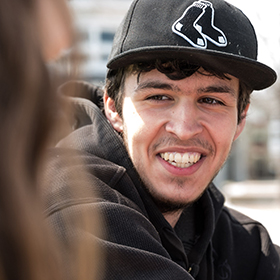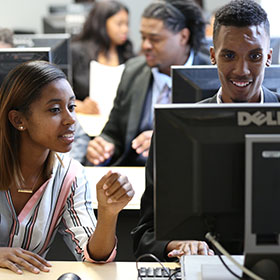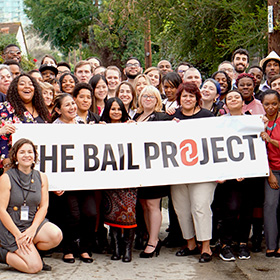Blue Meridian
Finding the Pathways to Scale
 Youth Villages helps kids aging out of foster care
Youth Villages helps kids aging out of foster care
Nancy Roob knows Youth Villages inside and out. Having supported the pioneering youth organization since 2004, first as president of the Edna McConnell Clark Foundation (EMCF) and now as chief executive officer of Blue Meridian Partners, Roob appreciates the track record and potential of the organization's YVLifeSet® program to help youth aging out of foster care become successful adults.
But after a decade of work with the program, which supports kids aging out of the foster care system, Roob could see it was reaching only a fraction of the young people who needed help navigating the difficult transition to adulthood.
"For years, Youth Villages could not imagine any strategy other than the Youth Villages' team directly engaging in replication and managing it themselves," says Roob, who's been helping to scale effective social innovations for the past two decades. When she began incubating EMCF's new funder collaborative, Blue Meridian Partners, in 2015, she committed to making even larger investments to achieve transformative change.
It's a commitment Bridgespan appreciates fully: "If you asked what the singular central question Bridgespan is grappling with as it works with nonprofits and has since its inception, it’s the question of 'How do you scale and increase the impact that’s there?' " says Bridgespan's Managing Partner and Co-founder Jeff Bradach. Roob and Bridgespan have like minds when it comes to scaling impact—and have collaborated in this pursuit for nearly 20 years. Bridgespan Partner and Head of Consulting William Foster credits Roob with a singular focus on evidence and track record, as well as an enormous capacity for hard work. "The notion of truly being an investor and orienting around results rather than inputs shouldn't be so shocking," says Foster. "Unfortunately, it's just abnormal behavior out there in the world, but Roob does it all the way."
Increasing the impact of Youth Villages
For Roob, "doing it all the way" for Youth Villages meant, in part, engaging Bridgespan to help create the organization's next business plan. Over the years, EMCF and Blue Meridian have called on Bridgespan many times to help grantees hone their strategies as well as help vet and work with grantees. This was the tenth plan Bridgespan has assisted Youth Villages with in the past 14 years.
 As part of Youth Village's desire to understand different avenues to scale, Bridgespan spent time on the ground interviewing other youth service providers to understand the circumstances under which Youth Villages might consider partnering and to identify criteria for partnering. "That was a very game-changing moment for Youth Villages and for us, because they and we could actually see a bigger pathway to scaling," says Roob
As part of Youth Village's desire to understand different avenues to scale, Bridgespan spent time on the ground interviewing other youth service providers to understand the circumstances under which Youth Villages might consider partnering and to identify criteria for partnering. "That was a very game-changing moment for Youth Villages and for us, because they and we could actually see a bigger pathway to scaling," says Roob
"Being a direct service provider, entering new communities as an outsider and competing with longstanding local providers, Youth Villages had a hard challenge to keep moving into new states" says Foster, who traveled with Youth Villages' CEO Patrick Lawler to pitch the new plan to new states. "So Youth Villages considered how on-the-ground work could be done with some of the best local players. To say that it's actually possible to think about being in all of the states with this work really changed Youth Villages’s strategic horizon."
Bridgespan also analyzed the population of young people who would benefit from the YVLifeSet program in each state and the potential cost savings to those states. This analysis revealed certain states with high concentrations of young people who would benefit from Youth Villages’ services—and a starting place for Youth Villages' expansion. "Being able to map that analysis with the partner selection analysis led to a roadmap for thinking about how to approach scale differently," says Roob.
Relentless pursuit
Youth Villages' breakthrough is an apt example of the kind of pathways to scale Roob is looking for across Blue Meridian's work. She and the Blue Meridian team spend their days exploring strategies to change the lives of young people and families and supporting the organizations—often with Bridgespan's help—to identify how to reach more people. "That's at the heart of all we're doing at Blue Meridian," says Roob.
 As an innovative funder collaborative, Blue Meridian pools philanthropic dollars to support some of the highest-performing and highest-potential nonprofit organizations. In late 2018, Roob and Blue Meridian Board Chair Stanley Druckenmiller announced that Blue Meridian would become independent from EMCF, marking an important next step for an organization that has become a pioneering force for both social change and philanthropy. By way of explanation, Druckenmiller, founder of Duquesne Investments and an early funder of Harlem Children's Zone, told the New York Times, "I'm not rich enough to [reduce childhood poverty] alone." But with Blue Meridian, Druckenmiller is one of 14 partners who have entrusted a combined $1.7 billion and counting.
As an innovative funder collaborative, Blue Meridian pools philanthropic dollars to support some of the highest-performing and highest-potential nonprofit organizations. In late 2018, Roob and Blue Meridian Board Chair Stanley Druckenmiller announced that Blue Meridian would become independent from EMCF, marking an important next step for an organization that has become a pioneering force for both social change and philanthropy. By way of explanation, Druckenmiller, founder of Duquesne Investments and an early funder of Harlem Children's Zone, told the New York Times, "I'm not rich enough to [reduce childhood poverty] alone." But with Blue Meridian, Druckenmiller is one of 14 partners who have entrusted a combined $1.7 billion and counting.
For Roob, this is just the beginning. "Within 10 years, I envision a new normal, where dozens if not hundreds of funders join together, so that funding flows more rationally and robustly to leaders with proven strategies for solving big social problems," she said in a TEDx Talk in 2017.
Achieving population-level change
"Blue Meridian is very much a bet that one of the barriers [to transcending poverty] is capital, that we're betting too small, so we need to be able to deploy larger chunks of capital," says Bradach. "Because of the scale of the investment, they can actually think about achieving true population-level change."
Youth Villages now has an 11-year scaling plan to bring about population-level change for foster care youth. Blue Meridian has pledged $36.1 million over four years to deliver YVLifeSet to young adults in nine to 11 states through a combination of partnerships with local providers and direct service by Youth Villages.
Blue Meridian's other investments include some of the most promising organizations working in youth development today, including Year Up, Upstream USA, Wendy's Wonderful Kids (a program of the Dave Thomas Foundation for Adoption), and more. "Ideally, we actually want to solve problems," says Roob.
The Bail Project Puts the "Free" In Freedom
On any given night, 450,000 people in America's local jails are there because they can't pay bail. When held in jail for misdemeanors, 90-percent of people plead guilty just to get out—saddling them with criminal records and jeopardizing their housing, employment, and more.
 In 2007, public defenders Robin Steinberg and David Feige founded the Bronx Freedom Fund, betting big that if low-income people were able to pay bail and return to their communities before trial, that money would come back, and it could be used to bail out many more people who would otherwise be detained because they couldn't afford to pay bail. The bet worked: when the Bronx Freedom Fund paid bail, 96-percent of people came back for every court appearance—debunking the myth that people will only come back if their money is at stake.
In 2007, public defenders Robin Steinberg and David Feige founded the Bronx Freedom Fund, betting big that if low-income people were able to pay bail and return to their communities before trial, that money would come back, and it could be used to bail out many more people who would otherwise be detained because they couldn't afford to pay bail. The bet worked: when the Bronx Freedom Fund paid bail, 96-percent of people came back for every court appearance—debunking the myth that people will only come back if their money is at stake.
With The Bail Project, Steinberg is taking her experiment to the next level. "When the Bail Project articulated the idea of doing this nationally and gathering data and stories in a more systematic way that could then influence policy change, that was really compelling to us and Blue Meridian," says Bridgespan Partner Kristen Loureiro.
Blue Meridian engaged Bridgespan to work with The Bail Project to develop a scaling plan. As they bring their model to communities across the country, The Bail Project is demonstrating what truly helps people come back for court dates, such as court reminders, cards for gas or public transportation, and referrals for childcare.
In 2019, Blue Meridian pledged to invest $37.5 million over five years to help The Bail Project serve more than 100,000 individuals in 25 diverse jurisdictions, while also capturing the data that they expect will prove cash bail unnecessary and end the inequitable practice of setting bail that is unaffordable to low-income people once and for all.
Created: July 2019
